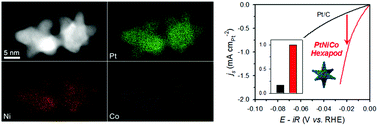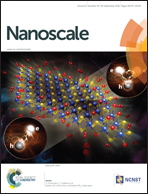Rational design of Pt–Ni–Co ternary alloy nanoframe crystals as highly efficient catalysts toward the alkaline hydrogen evolution reaction†
Abstract
The rational design of highly efficient electrocatalysts for the hydrogen evolution reaction (HER) is of prime importance for establishing renewable and sustainable energy systems. The alkaline HER is particularly challenging as it involves a two-step reaction of water dissociation and hydrogen recombination, for which platinum-based binary catalysts have shown promising activity. In this work, we synthesized high performance platinum–nickel–cobalt alloy nanocatalysts for the alkaline HER through a simple synthetic route. This ternary nanostructure with a Cartesian-coordinate-like hexapod shape could be prepared by a one-step formation of core–dual shell Pt@Ni@Co nanostructures followed by a selective removal of the Ni@Co shell. The cobalt precursor brings about a significant impact on the control of size and shape of the nanostructure. The PtNiCo nanohexapods showed a superior alkaline HER activity to Pt/C and binary PtNi hexapods, with 10 times greater specific activity than Pt/C. In addition, the PtNiCo nanohexapods demonstrated excellent activity and durability for the oxygen reduction reaction in acidic media.


 Please wait while we load your content...
Please wait while we load your content...